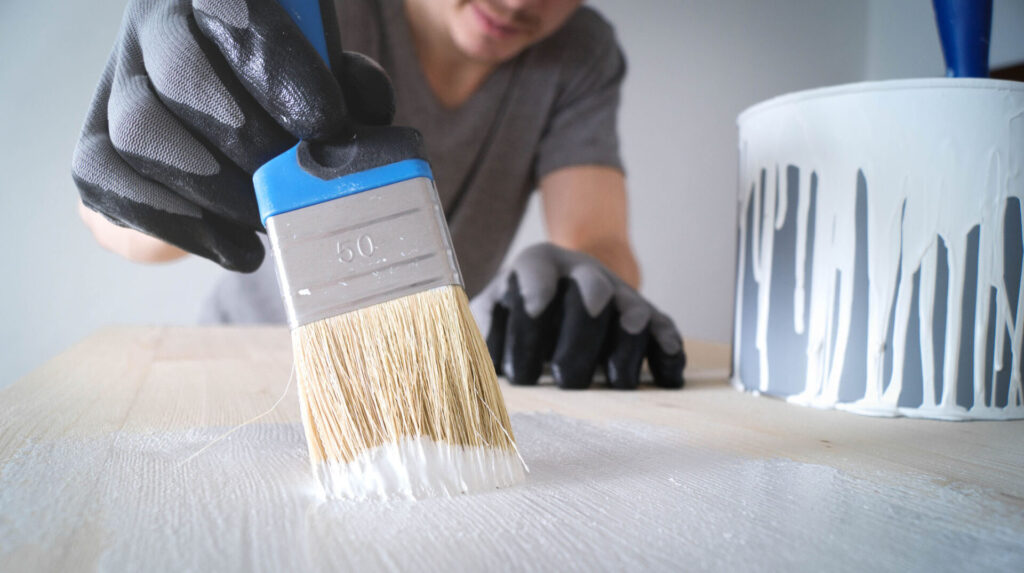Table of contents
Table of contents
Table of contents
Contributors
My main focus is managing the blog and product content for the Protectivity website ensuring everything aligns wi...
Have you ever wondered how to become a painter and decorator? If you love making interiors look great, applying some flair and creativity, and working out and about rather than in an office, it could be the career for you. And at a time when demand for good tradespeople continues to outstrip supply, it’s a chance for you to potentially earn some really good money in the long-term. But if you’ve never explored painting and decorating as a career option before, where do you start?
This guide tells you all you need to know about how to become a painter and decorator. You’ll discover your day-to-day duties, the qualifications and skills you’ll need, how much you could potentially earn, and what you need to consider when setting up a business.
What does a painter and decorator do?
The range of duties and jobs that professional painters and decorators are hired for is huge. That’s because every home and building is different, and every client has different ideas about what they’d like to see.
First of all, when looking at how to become a painter and decorator, it’s important to remember that the job isn’t just restricted to people’s homes. The same services are just as in demand in commercial settings like shops, and in industrial environments like offices. This is good news for you as it gives you the opportunity to differentiate your skills and business, and stand out more from the competition in your area.
From a more practical, day-to-day perspective, your responsibilities may include some or all of the following:
Mixing paint and applying it to walls, ceilings and other materials
Applying primer or undercoat
Carrying out repairs to surface, such as filling cracks
Pasting and applying wallpaper
Stripping old surfaces for new substances to be applied
Surveying and measuring environments, both for quotation and to determine the quantity of materials required
What qualifications do I need to be a painter and decorator?
Technically speaking, there is no legal requirement to become a painter and decorator. However, it’s strongly recommended that you get some formal training and qualifications behind you. Without them, it will be extremely difficult to get a job with a decorating business, which will want concrete evidence of your capabilities. Similarly, if going down the self-employed route, then customers will be more likely to trust you if they can see any reliable credentials of your skills.
The good news is that there is a wide variety of courses and qualifications you can take to get the certification you need. Perhaps one of the most common is the Painting and Decorating NVQ, starting at Level 1. This initial course gives you theoretical and practical experience of using the right materials, best practice in health and safety, the range of products available to you, and being able to mix and apply paints, varnish and sanding.
From this, you can move onto Level 2, which brings in paint and surface preparation, up-to-date techniques, and further information around business and customer management. Level 3 takes these skills to the next level and allows you to gain a Gold Advanced Craft Card, which stands you out as a highly competent painter and decorator.
Alternatively, you can go down the City & Guilds route, starting with the Basic Wallpapering course. From this you can take the Intermediate and Advanced Painting & Decorating courses, and gradually build up the knowledge and practical skills that you need over time.
Some of the courses available do have the option for online learning, but it’s important to check what the facilities are for practical training in your area.

How long does it take to become a qualified painter and decorator?
This depends on the type of courses you take, and whether you’re learning full-time or gaining your qualifications on-the-job. Using NVQs as an example, in most vocational professions it generally takes between one and two years to reach Level 3 from a standing start.
You may find some colleges and training providers offer ‘intensive’ training that allows you to gain qualifications in much shorter timeframes. However, you should never neglect the value of practical experience: you’ll never stop learning as a painter and decorator, and practice will ultimately make perfect!
What skills do I need to be a painter and decorator?
First and foremost, painting and decorating is a practical and hands-on job, so you’ll need to be good with your hands! Perhaps just as importantly, you’ll need to have a strong work ethic: you may well be required to work outdoors, in difficult conditions, and sometimes at unsociable hours like evenings and weekends.
One skill set you might not associate with the profession – but can be a real differentiator – is computer proficiency. That’s because the planning of painting and decorating is becoming increasingly digitised, with digital colour charts and paint mixing apps taking some of the guesswork out of the job. So, if you’re good with computers, it can add another useful line to your CV. Painting and decorating also requires a decent level of mathematical skills, so that you can work out quantities of materials, and formulate quotations.
If you intend to work on building sites at any time, then it will also be a legal requirement for you to gain a Construction Skills Certificate Scheme (CSCS) card.
What tools and equipment do I need?
You’ve probably already worked out that you’re going to need paint, brushes and rollers if you’re going to be a painter and decorator. But that’s only a small amount of the equipment that you’ll need. Other equipment and tools required includes (and is not necessarily limited to):
Trays for brushes and rollers, and materials for cleaning them
Dustsheets and other measures for protecting items from paint damage
Sandpaper and other abrasive items that help prepare areas for decoration
Stanley knives, spirit levels and stepladders
Suitable clothing and footwear that will keep you clean and safe
A first-aid kit in case of an accident or injury
This is by no means an exhaustive list, and you may have further requirements depending on the environment you’re working in. For example, on a building site, steel-capped boots and a hard hat will be mandatory, even if the work you’re doing isn’t especially dangerous or heavy-duty.
If you’re taking a job with a professional decorating firm, make sure you check in advance how much equipment is going to be provided. Some may lay on everything you need, while others may expect you to bring some of your own stuff with you.

How much can painters and decorators make?
The range of potential earnings on offer for professional painters and decorators is substantial, and there are two main reasons for this. The first is that the public is willing to pay a premium for access to good-quality workmanship with an excellent reputation, especially as skilled tradespeople are in particularly short supply at present. The second is that your earning power is potentially limitless if you’re self-employed or run your own business, rather than earning a fixed salary working for someone else.
According to the National Careers Service, a full-time employed painter and decorator can expect to earn anywhere between £17,000 and £32,000 a year, depending on location and experience. But if you’re running your own business, your rates (minus expenses and overheads) are up to you, meaning your earnings can increase by a substantial margin.
Business formation
Firstly, you should decide the legal status of your business, and there are two main options open to you. The first (and simplest) is to operate as a sole trader, which is preferable if you’re intending to work on your own. This means that your income and expenditure is directly tied to your own personal finances, and are assessed for tax when you fill out your Self-Assessment every year. But there is a downside: if you fall into debt, including if a claim for compensation is made against you, then you are personally liable for the bill. In the worst case scenario, your home could be at risk if you have no other way of settling the bill.
The safer, but slightly more complex option, is to set yourself up as a limited company. This means you have a degree of separation between your business finances (operated through a business bank account) and your own affairs. It also means that any debts are the responsibility of the business rather than you personally. This can make things much clearer from an operational point of view if your business will be relatively complicated, and especially if you intend to hire other people to work for you.
Setting prices and rates
The next step is to work out how much you intend to charge per hour for your services, and there are two defining factors at play here. The first is how much other firms in your area charge: you may want to charge a little less to attract business to begin with, but this will naturally limit your potential profitability.
The second consideration is your expenses, from your wages and earnings, through transport to different sites, to the materials, tools and equipment you need to do the job. When you quote for different jobs, it’s vital you take materials into account as well as labour, so that there is a decent amount left over for yourself.
Marketing and promotion
Your ideal starting point for marketing your services is to set up a simple website that details your skills and services, and link it to some social media platforms on which people can find you and enquire. However, don’t neglect the usefulness of more traditional forms of marketing: flyers, posters and adverts in your local newspapers are still often relied upon by people looking for reliable tradespeople.
Legal and insurance
When you run a business, you’ll be required to comply with a range of different legal frameworks, health and safety perhaps being one of the most important. But there are others to take into account, too, especially if you’re employing other people: you’ll need to pay Employer’s National Insurance, and take out a tradesman insurance policy that encompasses cover for employees. In any case, covering your business with specific painter and decorator insurance is always a good idea, given the potential for an accident or incident that can be disruptive and expensive.
Affordable painter and decorator insurance from Protectivity
Even the best and most experienced painters and decorators get things wrong at times – nobody is perfect, after all! The only problem is that from a business perspective, mistakes, incidents and accidents can become expensive.
At Protectivity, we provide affordable painter and decorator insurance cover specialising in small businesses. Our policies include public liability, products liability, commercial legal protection, and employers’ liability if you hire other people. That way, when unforeseen circumstances occur, you and your business won’t end up out of pocket. We now also offer insurance for your tools to help protect you should they be stolen or damaged.
Take two minutes today to take a closer look at our painter and decorator insurance policies.
Get Painters and Decorators Insurance from Protectivity
*Disclaimer – This blog has been created as general information and should not be taken as advice. Make sure you have the correct level of insurance for your requirements and always review policy documentation. Information is factually accurate at the time of publishing but may have become out of date.
Last updated by

















